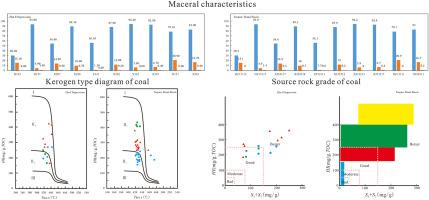Hydrocarbon generation characteristics and potential of liptinite-rich coal in China
IF 3.6
引用次数: 0
Abstract
Coal-measure source rocks may play an important role in hydrocarbon generation in petroliferous basins where coal seams are well developed. Hydrocarbon generation characteristics and potential of coal-measure source rocks have been well documented for continental petroliferous basins, while the understanding of coal-measure source rocks in offshore basins is yet to be delved into. Significant oil exploration breakthroughs have been made in the well-developed coal measures of Turpan–Hami Basin (THB), a typical continental petroliferous basin in northwestern China. In this study, a comparative analysis is conducted on the Paleogene coal seams in the Zhu I Depression (ZID), located in the northern part of the South China Sea, and the Jurassic coal seams in the THB in terms of genetic conditions, mineral composition, and hydrocarbon generation potential. The geological understandings are obtained as follows. Both the coal-forming periods during the deposition of the ZID and THB were of a warm and wet climate type. The Paleogene coal-forming environments during the deposition of the ZID mainly include peat swamp in the upper plain and interdistributary bays in the lower plain of the braided river delta, along with littoral shallow lakes. As a whole, the coal seams are characterized by multiple layers, thin single layer thickness and poor stability, while those in the upper plain peat swamp of the braided river delta have relatively larger single layer thickness but relatively fewer number of layers. The Jurassic coal-forming environments in the THB include peat swamp in the upper delta plain, lower delta plain, and inter-delta bay. The coal seams formed in the lower delta plain are the most stable, while those in the inter-delta bay are the thickest. The ZID coal has a higher vitrinite content (averaging 76.11 %) and liptinite content (averaging 10.77 %) compared to its THB counterpart, which has an average vitrinite content of 68.28 % and average liptinite content of 7.61 %. The kerogen of the ZID coal is mainly of type II1, while that of the THB coal mainly of type II2, followed by type Ⅲ. Both the ZID and THB coals have entered the oil-generation window, as indicated by their maximum vitrinite reflectance values (Ro, max, %), reflecting good oil generation capacity. However, the hydrocarbon generation potential of the ZID coal is higher than that of the THB.

中国富脂质煤的生烃特征及潜力
煤系烃源岩在煤层发育的含油气盆地中具有重要的生烃作用。陆相含油气盆地煤系烃源岩的生烃特征和潜力已有较好的文献记载,而对近海盆地煤系烃源岩的认识还有待深入。吐哈盆地是中国西北地区典型的陆相含油气盆地,煤系发育良好,油气勘探取得重大突破。本文对南海北部朱一坳陷古近系煤层与THB侏罗系煤层在成因条件、矿物组成和生烃潜力等方面进行了对比分析。地质方面的认识如下。ZID和THB沉积时期的成煤期均为暖湿气候型。ZID沉积时期的古近系成煤环境主要为辫状河三角洲上平原的泥炭沼泽和下平原的分流间湾以及沿岸浅湖。总体上,辫状河三角洲上部平原泥炭沼泽煤层具有层数多、单层厚度薄、稳定性差的特点,而辫状河三角洲上部平原泥炭沼泽煤层单层厚度较大,层数较少。塔里木盆地侏罗系成煤环境包括三角洲上平原泥炭沼泽、三角洲下平原泥炭沼泽和三角洲间海湾。下三角洲平原形成的煤层最稳定,三角洲间海湾形成的煤层最厚。ZID煤的镜质组含量(平均76.11%)和脂质组含量(平均10.77%)高于THB煤的镜质组含量(平均68.28%)和脂质组含量(平均7.61%)。ZID煤的干酪根以II1型为主,THB煤的干酪根以II2型为主,其次为Ⅲ型。ZID煤和THB煤的最大镜质体反射率值(Ro、max、%)均已进入生油窗口,反映出较好的生油能力。ZID煤的生烃潜力高于THB煤。
本文章由计算机程序翻译,如有差异,请以英文原文为准。
求助全文
约1分钟内获得全文
求助全文

 求助内容:
求助内容: 应助结果提醒方式:
应助结果提醒方式:


